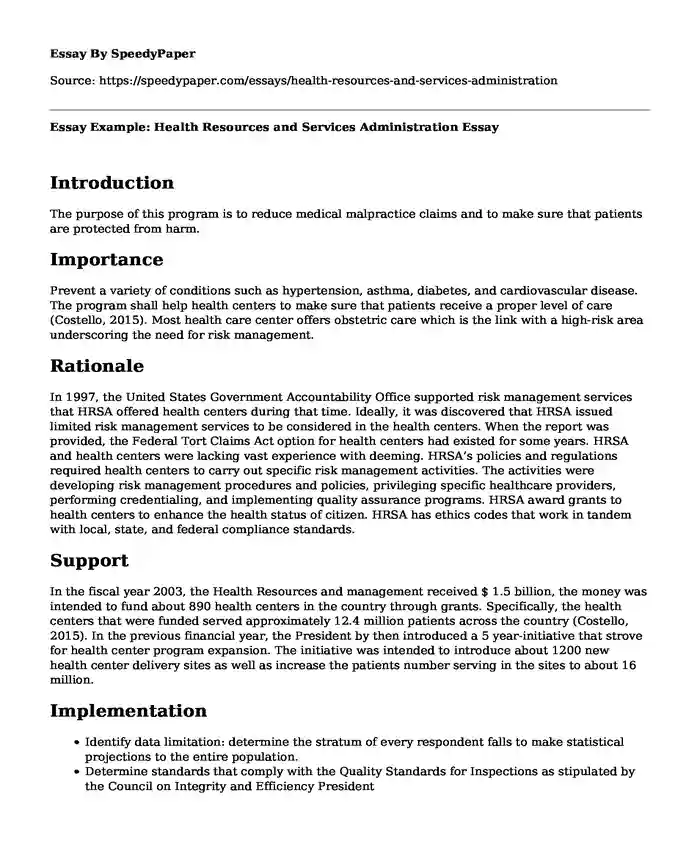
| Essay type: | Process essays |
| Categories: | Strategy Problem solving Healthcare policy Community health |
| Pages: | 3 |
| Wordcount: | 596 words |
Introduction
The purpose of this program is to reduce medical malpractice claims and to make sure that patients are protected from harm.
Importance
Prevent a variety of conditions such as hypertension, asthma, diabetes, and cardiovascular disease. The program shall help health centers to make sure that patients receive a proper level of care (Costello, 2015). Most health care center offers obstetric care which is the link with a high-risk area underscoring the need for risk management.
Rationale
In 1997, the United States Government Accountability Office supported risk management services that HRSA offered health centers during that time. Ideally, it was discovered that HRSA issued limited risk management services to be considered in the health centers. When the report was provided, the Federal Tort Claims Act option for health centers had existed for some years. HRSA and health centers were lacking vast experience with deeming. HRSA’s policies and regulations required health centers to carry out specific risk management activities. The activities were developing risk management procedures and policies, privileging specific healthcare providers, performing credentialing, and implementing quality assurance programs. HRSA award grants to health centers to enhance the health status of citizen. HRSA has ethics codes that work in tandem with local, state, and federal compliance standards.
Support
In the fiscal year 2003, the Health Resources and management received $ 1.5 billion, the money was intended to fund about 890 health centers in the country through grants. Specifically, the health centers that were funded served approximately 12.4 million patients across the country (Costello, 2015). In the previous financial year, the President by then introduced a 5 year-initiative that strove for health center program expansion. The initiative was intended to introduce about 1200 new health center delivery sites as well as increase the patients number serving in the sites to about 16 million.
Implementation
- Identify data limitation: determine the stratum of every respondent falls to make statistical projections to the entire population.
- Determine standards that comply with the Quality Standards for Inspections as stipulated by the Council on Integrity and Efficiency President
- Develop an active quality improvement program, which entails conducting long-term projects and reviewing clinical outcomes that are centered on improving clinical care.
- Establish appropriate use of clinical strategies
- Ensure there is clear communication with the patients and providers
- Establish comprehensive patient medical records
- Issue credentials of health care practitioner
- Document the informed consent
- Identify the patient grievance mechanism which focusses on addressing , collecting, and analyzing complaints raised by staffs and patients
- Conduct an internal incident reporting system
- Verify the ongoing patient cases’ peer review
- Identify the risk management practices and onsite risks’ assessment
- Establish a patient tracking system
- Create up-to-date procedures and policies on risk management
- Challenges Financial resources are the major challenges
- Inadequate staffing
- Lack of proper training of healthcare professional
- Lack of patient tracking records
- Evaluation Self-assessment is proactively performed by some departments
- Performing of a periodic environment of care using Joint commission and State Licensing auditors
- Visiting emergency rooms by management during night shifts
- Performing emergency medical report audits every day
- Conducting a monthly risk assessment walk via the safety committee
- Performing monthly safety audits at every site for clinical and non-clinical centers.
- Opportunities Quality improvement programs are needed, which shall entail the double-checking of dispensing drugs (Mora & Walker, 2016).
- Patient satisfaction is the other aspect that must be considered.
References
Costello, S. (2015). Female genital mutilation/cutting: Risk management and strategies for social workers and health care professionals. Risk Management and Healthcare Policy, 225. doi:10.2147/hp.s62091
Mora, A. M., & Walker, D. (2016). Quality improvement strategies in accountable care organization hospitals. Quality Management in Health Care, 25(1), 8-12. doi:10.1097/qmh.0000000000000081
Cite this page
Essay Example: Health Resources and Services Administration. (2023, Aug 10). Retrieved from https://speedypaper.com/essays/health-resources-and-services-administration
Request Removal
If you are the original author of this essay and no longer wish to have it published on the SpeedyPaper website, please click below to request its removal:
- Essay Sample on Obesity, Hyperlipidemia, Hypertension, and Type 2 Diabetes
- Free Essay About Accounting Analyst Career
- Free Essay Example: Various Aspects of Franchising
- Essay Sample on Analyze the Different Aspects of Medicare Programs
- Essay Sample on Expanding a Business Model
- Paper Example. Psychiatric Community
- Free Essay on Global Athletic Footwear Market
Popular categories




